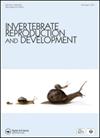野外采集的伊蚊未成熟阶段是否表现出和生活史特征相一致的特征?来自印度加尔各答的观测
IF 0.8
4区 生物学
Q4 REPRODUCTIVE BIOLOGY
引用次数: 0
摘要
摘要登革热媒介埃及伊蚊(Linnaeus,1762)和白纹伊蚊(Skuse,1894)的昆虫学监测为生活史特征提供了重要信息。使用从印度加尔各答不同幼虫栖息地随机收集的未成熟阶段,对伊蚊的LHT进行了评估。在104个幼虫栖息地中,约43%是埃及伊蚊的专属栖息地,约31%是白纹伊蚊的专用栖息地,约26%是两个物种的常见栖息地。雌性和雄性埃及伊蚊的蛹重、成虫重和翅长均大于白纹伊蚊。所有LHT均显著相关(P<0.05),并且两种伊蚊的两性异形都很明显。埃及伊蚊和白纹伊蚊的繁殖力(ln转换值;y)随翅膀长度(x)的增加而增加[埃及伊蚊y=1.012x+1.023,R2=0.455,白纹伊虫y=1.022x+1.083,R20.154]。在登革热媒介监测中,将生活史特征数据与蛹生产力相结合,将能够准确预测种群数量和疾病传播的可能性。本文章由计算机程序翻译,如有差异,请以英文原文为准。
Do field collected immature stages of Aedes mosquitoes exhibit correspondence of the life-history traits? Observations from Kolkata, India
ABSTRACT Entomological monitoring of dengue vectors Aedes aegypti (Linnaeus, 1762) and Ae. albopictus (Skuse, 1894) (Diptera: Culicidae) provides crucial information on the life-history traits (LHTs). An assessment of the LHTs of Aedes mosquitoes was accomplished using randomly collected immature stages from various larval habitats of Kolkata, India. Out of 104 larval habitats ~43% were exclusive for Ae. aegypti, ~31% were exclusive for Ae. albopictus and ~26% were common for both the species. Both female and male Ae. aegypti were bigger than the equivalents of Ae. albopictus in terms of pupal weight, adult weight and wing length. All the LHTs were significantly (P < 0.05) correlated, and the sexual dimorphism was evident for both Aedes mosquitoes. In both the species, the fecundity (ln-transformed value; y) increased with the wing length (x) [for Ae. aegypti y = 1.012x+1.023, R2 = 0.455, and for Ae. albopictus y = 1.022x+1.083, R2 = 0.154]. A correspondence of the larval development and the adult traits was evident for both the Aedes mosquitoes. Incorporation of the life-history trait data with pupal productivity in the surveillance of the dengue vectors will enable precise predictions about the population abundance and possibility of disease transmission.
求助全文
通过发布文献求助,成功后即可免费获取论文全文。
去求助
来源期刊
CiteScore
1.90
自引率
0.00%
发文量
21
审稿时长
>12 weeks
期刊介绍:
Invertebrate Reproduction & Development ( IRD) presents original research on the reproductive and developmental biology of the Invertebrata, both embryonic and postembryonic. IRD welcomes papers reporting significant results obtained using new techniques. Encouraged topic areas include: aquaculture, physiology, biochemistry, functional morphology, phylogeny, behavioural and regulatory mechanisms, including genetic, endocrine and molecular studies. Papers containing qualitative descriptions of reproductive cycles and gametogenesis will not be considered. IRD is published in association with the International Society of Invertebrate Reproduction and Development.

 求助内容:
求助内容: 应助结果提醒方式:
应助结果提醒方式:


